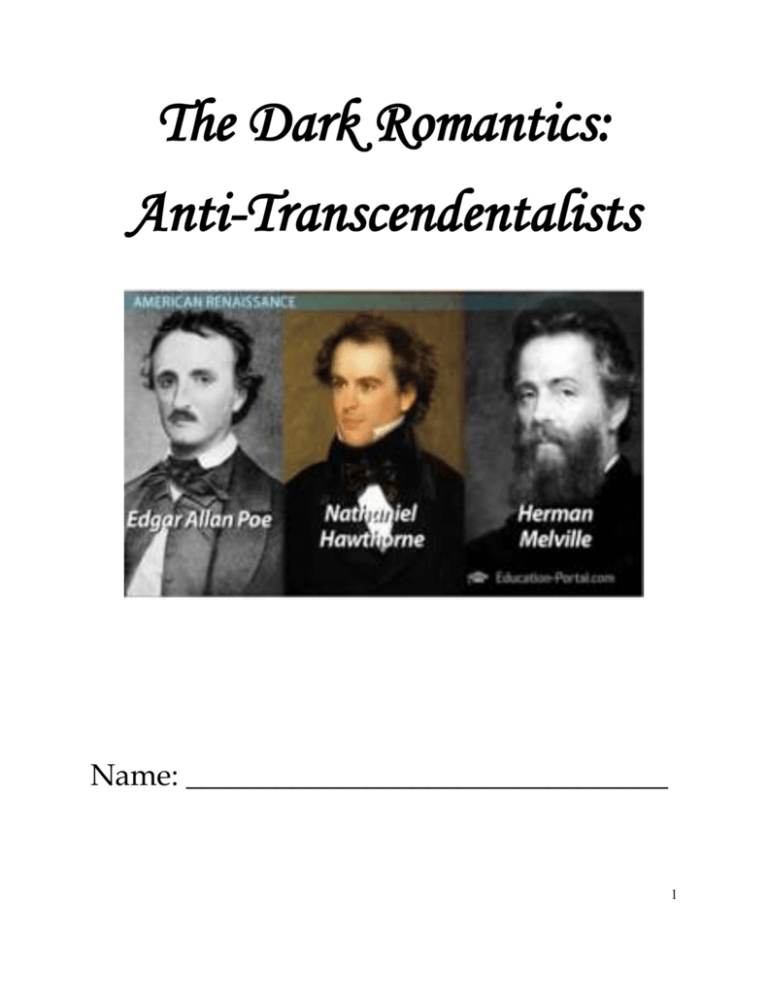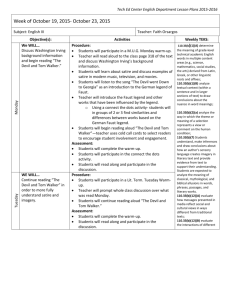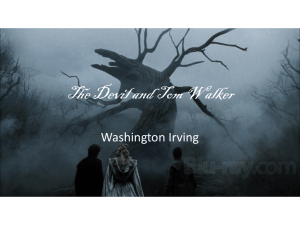The Dark Romantics: Anti-Transcendentalists Name: ______ Key
advertisement

The Dark Romantics: Anti-Transcendentalists Name: ________________________________ 1 Key Traits of Anti-Transcendentalism DIRECTIONS: Consider the main traits of Transcendentalism. Use them to make predictions about what MAY be key traits of Anti-Transcendentalism, a reactionary movement. Transcendental Trait Anti-Transcendental Prediction Actual Trait Innate wisdom (Intuition) Human potential (Optimism) Eternal One Non-conformity Truth through observation Respect for nature Social Reform 2 The Dark Romantics in American Literature Heather Carroll Education Portal American Renaissance The American Renaissance in literature is actually a very specific part of the larger literary period, the American Romantic period. The Romantic period, which lasted roughly from 18001860, experienced an explosion of uniquely American literature near the end of the time period. This surge of American literary masterpieces from 1840-1860 is known as the American Renaissance. During the American Renaissance, writers could generally be placed into one of two subgenres, or categories: the Dark Romantics and the Transcendentalists. In this video, we're going to look at the Dark Romantics. To begin, it's best to explain that Dark Romantic doesn't mean darkly romantic, so we're NOT thinking of a 50 Shades of Grey type-thing (I'm sorry to disappoint you) - though both are exploring the inner workings of the mind. Instead, we are talking about a subgenre of writing that took a shadowy approach to the fantastical. Poe, Hawthorne, and Melville were key Dark Romantic writers The Romantic writers took an optimistic approach to the mystical aspects of the universe where sins are properly punished and those who are truly good are rewarded. For example, in Washington Irving's 'The Devil and Tom Walker,' Tom Walker is punished for his greed. It's a moral tale to warn against hypocrisy and evil. On the other hand, the Dark Romantics, like Edgar Allan Poe, Nathaniel Hawthorne, and Herman Melville, sometimes called Gothic, were more serious and found the darkness and evil in those same aspects, with evil taking over the good. As a result, their writing typically has the following characteristics: 1. Lots of creepy symbols 2. Horrific themes 3. Psychological effects of guilt and sin 3 Symbols A symbol is something that represents something else. A red rose, for example, is a common symbol for love, romance, passion, and vitality. But if we change the color of the rose to black, it becomes a symbol of something more sinister - death, loss, and possibly evil. Authors use symbols to help readers make connections beyond the story itself. Sometimes objects in a story are symbols. Sometimes characters are symbols. Most people are familiar with Edgar Allan Poe's poem 'The Raven,' which is a Dark Romantic piece of writing that is still popular today (even the The Simpsons have their own version). In that poem, the raven is a symbol for death and hopelessness as it sits and watches the narrator, who is slowly going mad. Poe could have chosen any bird, but he chose a bird who is known for hanging out at battlefields and picking away at the dead. These connections through the use of symbols are intentionally made by the author and reinforce the overall meaning of the story. For the Dark Romantics, sin and evil were everywhere, so their symbols often represent evil entities, like devils or spirits. These symbols often reinforce one of many horrific themes found in the story. Horrific Themes A story's theme is a statement that the text seems to making about the subject and for the Dark Romantics, this statement was drenched in terrifying ideas. In some cases, they studied the struggles of human nature. More specifically, they believed that human nature was less The Dark Romantics used evil beings as symbols for sin than good, so evil was able to take hold of a person. Like the Puritans before them, they believed evil and sin were everywhere, but it was not as easy to identify, so it could easily lead to self-destruction. It was not just human nature that harbored evil, though; the Dark Romantics also saw darkness in the external world. The idea that our surroundings could be filled with evil fueled much of their writing, encouraging readers to question everything around them. Edgar Allan Poe, a famous Dark Romantic writer, encompasses this theme in his short story 'The Fall of the House of Usher.' As despair takes over the home, it deteriorates and finally collapses. Of course, like many stories, the Dark Romantics knew that good was always battling evil, but unlike your typical super-hero movie, evil usually won out. But it wasn't simply the presence of evil that fueled the Dark Romantics' writing. They wanted to explore the horrors of evil that were lurking in everyone. This meant that they spent a good deal of time looking at the 4 character's thought processes. It's not enough to see the character's actions; we need to see his or her reasons for committing those actions in the first place. Poe wrote another story called 'The Tell-Tale Heart' that follows a murderer's increased paranoia after hiding a dismembered body under the floorboards. If you put all of these components together, you end up with more than your run-of-the-mill horror story. These stories are more like the movies Black Swan and American Psycho that follow the stream of consciousness deterioration of the mind than say, Scream and Saw which focus on actions. These writers want to know 'why' rather than 'how', so they focus on the psychological, or how the mind works. Psychological Effects of Guilt And Sin With all these horrific undertones and creepy symbols, it shouldn't be a surprise then that the characters in these stories are not your average storybook heroes. Mostly, though not always, Dark Romantic writers want to explore the The Scarlet Letter focuses on the psychological psychological effects of guilt and sin, so repercussions of sin and guilt we see characters who are harboring guilt for their sins, and that guilt leads to the grotesque, the fantastic, or the morbid. In other words, these characters are often deranged or go mad. It also means that the reader is often stuck in the character's mind, watching as it slowly deteriorates into that madness. Nathaniel Hawthorne illustrates this concept in his novel The Scarlet Letter. He tells the story of a minister whose affair with a married woman sends him into a guilt-ridden self-punishment, and ultimately death. Lesson Summary So, to sum up, the American Romantic period had an explosion of uniquely American literature at the end of the era, from about 1840-1860. During this time, the subgenre of Dark Romantic writers, including Edgar Allan Poe and Nathaniel Hawthorne, used creepy symbols and horrific themes to look at the inner-workings of the mind and to explore the psychological effects of guilt and sin. The result is a collection of short stories, poems, and novels that forced Americans to see that evil was lurking in us all. 5 Take notes on the following topics while watching the brief video. American Renaissance Symbols Horrific Themes Psychological Effects of Guilt And Sin 6 Complete the following outline during class discussion. Anti – transcendentalism Definition: When: Reasons / Causes Literary works Key Ideas / Philosophies 7 View of nature Writing style ______________________________________________________________________________ PRE – READING FOR: THE DEVIL AND TOM WALKER – by Washington Irving YES NO STATEMENT 1. There is a devil who tries to trick people. 2. Money is the #1 goal for most people today. 3. Integrity is more important than money. 4. When you marry, what is yours should become your spouse’s and vice versa. 5. It is okay to lie to your spouse if the lie will not hurt them. 8 The Devil and Tom Walker Name: ___________________ Washington Irving Pd: ______________________ Folk Tale Characters typify (exaggerate) certain human motivation / behavior Events are based on legend or hearsay (as opposed to history) Humorous tone, yet serious message(s) about human values is conveyed Mixture of realistic detail and elements of the supernatural Satire: A type of writing that ridicules various people, institutions, groups or humanity in order to set a moral standard for society Stock characters: Fictional characters that are based on common literary or social stereotypes. Stock characters rely heavily on cultural types or names for their personality, manners or speech. They are often used in satire and parody. Directions: Complete this worksheet WHILE you read. (Pages 202-213) 1. Where does the story take place? 2. Why was the inlet a good place for Kidd the pirate to hide his money? 3. Who guards the buried money? 4. Why does Kidd never return for his treasure? 9 5. What kind of people are the Walkers? Give an example which demonstrates their mindset on money. 6. Do the conflicts between Tom and his wife ever get physical? How do you know? 7. Why does Tom end up in the swamp? Where had he been? 8. What structure does Tom notice in the woods? What had it once been used for? 9. What does Tom discover in the ground while resting? 10. Describe in detail the appearance of the man Tom meets. 11. What is carved on many of the trees in the forest? What does this represent? 10 12. List at least 3 names by which the “black man” refers to himself. 13. Why does the author say Tom was not afraid of this man? 14. What deal does the devil propose? Surmise/take a guess at the conditions. 15. How does the man prove he is the devil? 16. What news does Tom receive when he returns home? Why is this ironic? 17. What do Tom and his wife argue about? What does she decide to do as a result? 18. List the possible explanations for Mrs. Walker’s disappearance. 11 19. When Tom reaches the swamp what does he realize must have happened? Why? How does he feel towards the devil? 20. What deal do the devil and Tom Walker make? What job must Tom take? 21. Why did so many people need money in Boston? What fever had struck? 22. Why does Tom decide to become a churchgoer? What is he trying to do? 23. Dramatic Irony is a literary device whereby a character inadvertently speaks the truth, foreshadowing tragic events of which he is unaware. Find the sentence in the conclusion of the tale where Tom makes this kind of ironic statement. 24. What do people say happened to Tom Walker? What became of all of his money? 25. Some tales about pacts with the devil end tragically for their heroes, illustrating the moral that one should never sell one’s soul. Explain the moral (theme or main message) of this tale. 12 Elements of Satire in The Devil and Tom Walker For each of the satirized elements, please complete the following: Explain how it is satirized Provide a piece of textual evidence from the story to support your idea Marriage Usury and the slave trade Religion Imagery: Record the details of the Woodsman in the following two categories. Woodsman as the Devil Woodsman as the common hunter What message is Irving sending through this imagery? Imagery: Record the details of the men whose names are seen on the trees. Attributes of the “great trees” Deacon Peabody and Crowninshield How does this foreshadow Tom’s demise? 13 Name: _________________________________________________ Washington Irving Writing a Thesis REMEMBER THIS FROM THE INTRODUCTORY NOTES? Key Topic: The Past Sparked by a new interest in American history Some authors draw on American legend and folklore Others dramatize the Revolution, conflicts with the Native Americans, etc. DIRECTIONS: As we read this critical article by Charles Zug, please keep in mind the information above. While you are reading try to determine Mr. Zug’s thesis; what is the statement he is trying to prove in his article? NOTES: (As you read write down any information you did not know about Irving or about the story “The Devil and Tom Walker”; highlight key ideas and points). 14 The Construction of The Devil and Tom Walker: A Study of Irving's Later Use of Folklore Zug, Charles G., III. "The Construction of The Devil and Tom Walker: A Study of Irving's Later Use of Folklore." [In the following essay, Zug talks about the aspects of common folklore that Irving incorporated into "The Devil and Tom Walker," particularly those he gathered in his travels to Germany. ] Although it is unquestionably one of Washington Irving's finest tales, "The Devil and Tom Walker" has never attracted much critical attention. First published in 1824 in Part IV of Tales of a Traveller, the tale recounts the fate of an avaricious New Englander, who sells his soul to the Devil in return for Captain Kidd's treasure, and is finally carted off to Hell after a long and profitable career as a usurer in colonial Boston. For the most part, critics have been content to note that the tale is "a sort of comic New England Faust," or that it "is redolent of the American soil." In other words, the consensus is that the tale has certain Germanic overtones but is indigenous to the young American republic in which Irving grew up. No one, however, has really attempted to examine the possible sources for this work or note the complex manner in which Irving has interwoven numerous motifs from American and German folklore.... At the outset, it is significant that no source has ever been discovered for "The Devil and Tom Walker." Most commonly, critics cite the Faust theme as the basis for the tale, but this is rather inaccurate, for Tom Walker is in no sense a scholar who desires to extend the limits of human knowledge. In actuality, it is not the Faust theme but the well-known motif M211, Man sells soul to devil, that lies at the heart of the tale. This, however, is only one of numerous folk motifs used, and taken by itself, it provides little insight into the source or structure of the tale. The problem here is that unlike "Rip Van Winkle" which is largely patterned on a complete tale, "The Devil and Tom Walker" is based on a series of folk motifs gathered by Irving from a wide variety of sources. It is important at this point to understand the exact distinction between a tale and a motif. The former is a complete and independent narrative which consists of one or more motifs traditionally associated with each other, while the latter is "the smallest element in a tale having a power to persist in tradition." Generally, motifs fall into one of three categories: "the actors in a tale," "items in the background of the action," and most commonly, "single incidents." Although based on folklore like "Rip Van Winkle," "The Devil and Tom Walker" is thus a much more complex and original work, for instead of starting with a fully developed plot, Irving began with a series of plot elements and fused them into a new and harmonious whole. That he was highly skilled in assembling these traditional motifs is evidenced by the number of critics who have accepted "The Devil and Tom Walker" as a rewritten version of a folktale that he had heard or read. To fully understand Irving's increasingly sophisticated use of folklore, it is necessary to briefly consider some of Irving's activities between the publication of The Sketchbook in 1819 and the writing of "The Devil and Tom Walker" in 1824. The key event here appears to have been the year-long tour through Germany in 1822 and 1823. Prior to this journey, Irving had shown an increasing interest in German lore and literature, and had been encouraged by Sir Walter Scott "to study the fascinating history of folklore." However, Irving's contact with German folklore at this time was limited to the few works over which he struggled to learn the German language and a number of English publications which were "Translated or adapted from the popular literature of Germany." The trip to Germany in 1822 gave Irving a new opportunity: a chance to investigate and gather up German folklore at first-hand. As he wrote to Thomas Storrow at the beginning of the tour, "I mean to get into the confidence of every old woman I meet with in Germany and get from her, her wonderful budget of stories." In other words, Irving was out to collect folklore in its purest state, directly from oral transmission. Stanley Williams notes this shift in Irving's attitude, commenting that "he now formed a resolution that folklore should not merely entertain the 15 knight-errant but should earn his lordship's bread and butter. He would really follow that impulse felt at Abbotsford in 1817 and create his volume of German legends. The tour now became a hunt for gnomes, pixies, and phantom armies; and he extended the journal into a saving bank for this species of coin." That the hunt was clearly successful is revealed by the numerous legends and scraps of lore that may be found in the letters and journals written during the German tour. At Salzburg, for example, Irving noted that "the mountain regions are full of fable and elfin story, and I had some wonderful tales told me." In his journal, he even wrote out seven local legends from this region, all of them concerned with the imposing figure of Untersberg Mountain. Walter Reichart points out that none of these legends appears to have a literary source, "so that it seems likely that Irving actually heard them from some of the inhabitants." Since Irving had little time or ability for reading German during his travels, this conclusion is almost inescapable. In addition, the letters and journals abound with fragments of and brief references to well-known tales and motifs, such as "the Emperor and his army shut up in the enchanted mountain" and "the Black Huntsman and the enchanted Bullets." Altogether, it appears that Irving rapidly enlarged his working knowledge of German folklore, and there are numerous entries indicating that he also enjoyed retelling the tales to his friends. The German experience thus served not only to increase his "savings bank" of potential source materials, but more important, to teach him the technique of combining and recombining these materials so as to form new tales. It is exactly this shift in emphasis, from written to oral sources, from the tale to the motif, and from the mere materials to the actual mechanics of folklore, that is reflected in "The Devil and Tom Walker" . As such, this tale suggests that a re-evaluation of Irving's later use of folklore is very much needed. As the following analysis reveals, Irving's use of folklore after his German tour was somewhat less "slavish" than most critics have been willing to admit.... Irving certainly never intended "The Devil and Tom Walker" to be taken as a folktale. His purpose was to produce an entertaining, fast-moving story based largely on German folk motifs and firmly rooted in an American locale. In conjunction with the prevalence of German motifs, it is important to note that practically the entire plot is made up of elements from folklore. In fact the only nontraditional portions of the plot are the two sections which I have labeled the domestic and financial subplots. The tale opens with three American motifs built around the legend of Captain Kidd. Immediately following is the domestic subplot, which is reminiscent of the marital situation in "Rip Van Winkle" and serves to develop the mutual enmity between Tom and his wife. Merely to infuriate her, Tom obstinately refuses to close his pact with the Devil. She, therefore, runs off with the family silverware to make her own bargain, and is apparently carried off by the Devil after an heroic struggle. After this humorous interlude, Irving immediately returns to the main plot of folk motifs, and it is not until after the pact is actually completed that he inserts the financial subplot. This section describes the state of affairs in colonial Boston, neatly delineating the avarice and religious hypocrisy of the inhabitants. With the uttering of the oath, Irving again returns to the main plot, and the tale moves swiftly to a close. Taken as a whole, the plot thus consists of a central chain of folk motifs into which two realistic subplots have been inserted.... Irving's choice of the Kidd legends as a framework for "The Devil and Tom Walker" was a good one, for it placed the tale in a distinctly American setting. Willard Hallam Bonner, who has made an extensive study of Kidd, notes that "the composite legend surrounding him is Saxon North America's first fullbodied legend." However, this legend is a limited one, in that it generally contains only a few, often recurring motifs. There is first a widespread belief that Kidd did bury his treasure, either along the southern New England coast or up the Hudson River. In addition, there is the belief that the treasure is guarded either by a slain sailor or worse, by "the Earl of Hell himself, at whose command Kidd `buried his Bible in the sand.'" As noted in the earlier plot outline, Irving used these American motifs at the beginning of the tale, although he shifted the place of burial to the Boston region. With the introduction of the domestic subplot, which follows immediately, Irving moved away from the Kidd legends and began 16 using German motifs which concerned the Devil. Apparently it was the Kidd stories heard from Colonel Aspinwall that gave Irving the initial inspiration and got the tale underway. Once started, Irving inserted the two realistic subplots and used the figure of the Devil, first mentioned in the American legend, as the means of transition to the numerous German materials.... Irving certainly never intended "The Devil and Tom Walker" to be taken as a folktale. His purpose was to produce an entertaining, fast-moving story based largely on German folk motifs and firmly rooted in an American locale. In this he was eminently successful, and"The Devil and Tom Walker" deserves to be ranked with "Rip Van Winkle"and "The Legend of Sleepy Hollow" as one of his best tales. Stanley Williams has pointed out that the major flaw in Tales of a Traveller was Irving's failure "to draw bravely from that wonderful stock of German legend in his notebooks and in his mind." While this analysis is true for most of these tales, it is clearly not applicable to "The Devil and Tom Walker", where the carefully assembled chain of German motifs provides the backbone for a unique and vigorous plot structure. Still a second valid criticism of the Tales of a Traveller is that Irving did not succeed "in transplanting German legends into American settings where the native landscape could reflect the spirit of the tale." Once again, "The Devil and Tom Walker" proves the exception, for Irving skillfully introduced the German materials through the use of the native Kidd legends, using the figure of the Devil as the unifying force for all of the motifs. By adding the two realistic subplots, a few brief character sketches, and some local history and legend, Irving succeeded in developing a truly American atmosphere. As William L. Hedge has observed, Irving was able "to bring certain aspects of Puritanism into dramatic focus by connecting Yankee shrewdness and Puritan respectability." As previously noted, this satire on the avarice and hypocrisy of colonial Boston is skillfully integrated with the folklore Irving used, and the final motif, Devil's money becomes ashes, is so well chosen that it serves as a fitting epilogue to the tale. Once the construction of "The Devil and Tom Walker" is laid bare, it becomes evident that Irving, at least after his German tour, was no "slavish" imitator but rather a highly skilled manipulator of both American and German folklore. In avoiding the stock Gothic machinery and a distant, foreign setting for an American locale, and in assembling a chain of folk motifs that was distinctly his own invention, he created a vigorous tale that is still very much alive and meaningful today. This is not to assert that Irving possessed a first-rank imagination, as his successors Poe and Hawthorne did. Instead, as his contemporary Coleridge might have observed, Irving was endowed with a mechanical rather than an organic imagination. In this sense, he is not unlike the medieval French author Chrétien de Troyes, who drew so heavily on traditional materials yet left his own stamp on them. Like Chrétien, Irving knew and understood the traditional storyteller's skill in relating folk motifs and so, in tales such as "The Devil and Tom Walker", he was able to recombine and reshape such motifs into new and significant forms. 17 The Minister’s Black Veil (pages 266-275 in textbook) By Nathaniel Hawthorne Background: Seventeenth-century Puritan New England, the setting of “The Minister’s Black Veil,” was steeped as much in superstition as religion – as you may remember from reading “The Crucible” earlier this year. To review, Puritans believed God was all-powerful and all-knowing. Their Theocratic society – a combination of laws based on The Bible and English law – perpetuated the idea that people were sinful by nature and deserved eternal punishment, but God “elected” some to be saved. In order to do this, Puritans tried to lead moral lives as a sign of being saved. Of course, this required people to keep a constant watch over themselves and others in order to fight the “natural tendency” to sin. Literary Terms: Parable – The subtitle of “The Minister’s Black Veil” is “A Parable.” A parable is a story that illustrates a moral lesson. In this way, parables resemble fables. Fables, however, usually have animal characters, whereas parables have human characters. Many famous parables appear in the Bible. The parable of the prodigal son, for example, teaches that one who turns away from evil should be forgiven. Hawthorne included the subtitle “A Parable” to alert his readers that he intended “The Minister’s Black Veil” to convey a moral lesson. Symbolism: Define the following term and as you read, record what the black veil symbolizes. Vocabulary: Define the following terms before you read. Perturbation Venerable Iniquity Sagacious Irreproachable Zealous Torpor 18 1) How does Hawthorne describe the veil? 2) How do the parishioners (people who are part of the church congregation) react (record 4) to the veil? Why do you think it affects them that way? Why? 3) What is the significance of the topic of the first sermon? What do you think is the connection between the veil and the congregation’s interpretation of Mr. Hooper’s sermon? Explain. 4) Why does the veil become an appropriate symbol in the afternoon service? What does one young woman “fancy” she sees? 5) Describe the impact of the minister’s veil on the wedding. Describe his exit from the service. Why might he respond like this? 19 6) Why might Elizabeth react as she does when Mr. Hooper refuses to remove the veil for her? How does this show her feelings for him? 7) How does the world outside the town react to the veil? How does this impact Hooper? 8) What do Father Hooper's final words disclose about his possible reasoning for wearing the veil? 9) Why do you think Hawthorne chose not to explain why Mr. Hooper wears the veil? How does this secret contribute to the story? 10) Ultimately, what is the one desirable effect of the black veil? 11) Finally, what message or moral lesson is Hawthorne sending in this parable? Cite a specific example from the story to support your position. 20 Message / Moral Lesson: Textual Evidence: Explanation: 21 “Young Goodman Brown” by Nathaniel Hawthorne 1. How does the setting add to the meaning of the story: sunset and night, dreary road, gloomy trees, etc? How does this imagery create the mood? How does this mood help us predict the nature of Young Goodman Brown’s journey? 2. Why do you think Faith wore pink ribbons? What is the connotation of this color? (Use a dictionary if needed). 3. Discuss the significance of the second traveler: “. . . [A man appeared] bearing a considerable resemblance to him, though perhaps more in expression than features. Still they might have been taken for father and son.” Is he Brown’s alter ego? (You may need to define this term first). 4. Interpret the description of the staff: “which bore the likeness of a great black snake, so curiously wrought that it might almost be seen to twist and wriggle like a living serpent. This, of course, must have been an ocular deception, assisted by the uncertain light.” What allusion is perhaps made here? 5. The fellow traveler states his knowledge of many members of Brown’s family as well as many important people from the town. What statement then is Hawthorne making about evil? 6. Discuss the meaning of the encounter with Goody Cloyse. “ . . . and in the very image of my old gossip, Goodman Brown, the grandfather of the silly fellow that now is.” 22 7. After Goodman Brown refuses to go any farther, the traveler throws him the maple stick and leaves. Discuss Good Brown’s attitude and conscience. 8. After the minister and Deacon Goodkin ride by, what happens with Goodman Brown? Why is this significant? 9. What does the black mass of the cloud symbolize – the confused and doubtful sound of voices? 10. Discuss the meaning(s): “My Faith is gone!” 11. Describe what Goodman Brown saw when he arrived at the meeting – the grave, reputable, and pious people, the chaste dames and dewy virgins, the revered pastor, and that the good “shrank not from the wicked”. Discuss the meaning. 12. The dark figure states, “Welcome, my children, to the communion of your race. Ye have found thus young your nature and your destiny.” Discuss. 13. How does Goodman Brown treat people the next day? What happens to him? Why? 14. “Young Goodman Brown” is a moral allegory. Essentially, an allegory is an extended metaphor – using one thing to represent another – a story with dual meanings. Therefore, there is a surface or literal meaning as well as a secondary meaning. In other words, Hawthorne uses this moral allegory to reveal a moral lesson or lesson. What moral lessons do you discover in this story? 23 QUOTE ANALYSIS Workshop: “Young Goodman Brown” Example #1: “[Brown] had taken a dreary road, darkened by the gloomiest trees of the forest, which barely stood aside to let the narrow path creep through, and closed immediately behind. It was all as lonely as could be; and there is this peculiarity in such a solitude, that the traveler knows not who may be concealed by the innumerable trunks and the thick boughs overhead; so that with lonely footsteps he may yet be passing through an unseen multitude” (Hawthorne). PLOT- LITERARY DEVICES- ANTI-TRANS TRAITS- ANALYSIS: Example #2: “Without more words, he threw his companion the maple stick, and was as speedily out of sight as if he had vanished into the deepening gloom. The young man sat a few moments by the roadside, applauding himself greatly, and thinking with how clear a conscience he should meet the minister in his morning walk, nor shrink from the eye of good old Deacon Gookin. And what calm sleep would be his that very night, which was to have been spent so wickedly, but so purely and sweetly now, in the arms of Faith! Amidst these pleasant and praiseworthy meditations, Goodman Brown heard the tramp of horses. . . and deemed it advisable to conceal himself. . . conscious of the guilty purpose that had brought him thither” (Hawthorne). PLOT- LITERARY DEVICES- 24 ANTI-TRANS TRAITS- ANALYSIS: Example #3: PLOT- LITERARY DEVICES- ANTI-TRANS TRAITS- ANALYSIS: 25 “What Redburn Saw in Launcelott’s-Hey” – Herman Melville Pre-reading: The main character, Willingborough Redburn, sails as a “cabin boy” on a merchant vessel bound for Liverpool, England. Upon arrival, he discovers something shocking in the port city’s streets and he attempts to offer help. This is a story of the lesson he learns. In the space below, spend 10 minutes free-writing about the following: What is the responsibility of the role of the “bystander” who sees or interacts with someone homeless or in need? Explain. Does the responsibility change if the person in need is a child? Explain. Do you have firsthand experience with this topic? If so, explain what happened. __________________________________________________________________ __________________________________________________________________ __________________________________________________________________ __________________________________________________________________ __________________________________________________________________ __________________________________________________________________ __________________________________________________________________ __________________________________________________________________ __________________________________________________________________ __________________________________________________________________ __________________________________________________________________ __________________________________________________________________ __________________________________________________________________ __________________________________________________________________ __________________________________________________________________ __________________________________________________________________ __________________________________________________________________ __________________________________________________________________ __________________________________________________________________ __________________________________________________________________ __________________________________________________________________ __________________________________________________________________ __________________________________________________________________ __________________________________________________________________ 26 “What Redburn Saw in Launcelott’s-Hey” by Herman Melville 1. What was the nature of the sound that attracted Redburn’s attention to the opening in the street called Launcelott’s-Hey? 2. What did Redburn see? 3. Describe Redburn’s reaction to what he saw? 4. What does Redburn learn about human nature from his attempt to get help for the destitute woman and her children? 5. What is the thought that Redburn hesitantly confesses after he has brought water and food to the dying woman and her children? Explain. 27 “What Redburn Saw in Launcelott’s-Hey” by Herman Melville DIRECTIONS: Complete the chart below as you read. Cite evidence from the text. What Redburn Sees Redburn’s Reactions, Thoughts, Actions The Townspeople Redburn “Accosts” The Townspeople’s Thoughts and Actions THEME: Based on your observations of the story, what do you think the theme of the story is? Record 2 possible themes below. 28








